Breastfeeding/Human Milk
Breastfeeding/Human Milk 1: Human Milk in the NICU
364 - Use of human milk vs bovine-derived fortifiers in infants <30weeks gestation or <1250g is associated with increased hypoglycemia and hyperphosphatemia
Publication Number: 364.101
.jpg)
Bridget E. Young, PhD (she/her/hers)
Assistant Professor
University of Rochester
University of Rochester School of Medicine and Dentistry
Rochester, New York, United States
Presenting Author(s)
Background: In 2017, our Level IV NICU switched from providing bovine-derived (BOV-fort) to human milk-derived human milk fortifiers (HM-fort) and donor human milk to infants born < 30 weeks gestation or < 1250g at birth. Since that time, providers anecdotally observed increased hypoglycemia, hypercalcemia, and hyperphosphatemia. We also recently reported increased feed extension orders due to hypoglycemia after switching to HM-fort.
Objective: To investigate potential metabolic aberrations among infants born < 30 weeks gestation or < 1250g who were provided bovine-derived fortifiers (BOV-fort) vs human milk-derived fortifiers (HM-fort).
Design/Methods: Lab measurements from qualifying infants born between 2015-2019, from birth to 37 weeks adjusted gestational age were analyzed. Infants who received both types of fortifiers were excluded. Logistic regression (for bivariate outcomes) and Generalized Estimating Equations modeling (for linear outcomes) was used to compare differences between groups controlling for ethnicity.
Results:
This data represented 493 infants: 287 in the BOV-fort group and 206 in the HM-fort group. Infant sex, race, gestational age, and birth weight were similar between groups. The HM-fort group had more ethnicity unreported and less Hispanic infants (p< 0.0001).
Average blood glucose was lower in the HM-Fort group (87.2 ± 25.6 vs 92.8 ± 25.1 mg/dL, p< 0.0001). The proportion of infants ever having a blood glucose < 60 mg/dL was higher in the HM-fort group (82% vs 67%, p< 0.0001) and the proportion of infants ever having a blood glucose ≤45 mg/dL was higher in the HM-fort group (46% vs 23%, p< 0.0001).
Average serum calcium was higher in the HM-Fort group (10.0 ± 0.7 vs 9.9 ± 0.6 mg/dL, p< 0.0001). However, the proportion of infants ever experiencing a serum calcium >11.4 mg/dL did not differ between groups.
Average serum phosphorus was higher in the HM-Fort group (5.6 ± 1.6 vs 5.4 ± 1.2 mg/dL, p< 0.0001). The proportion of infants ever experiencing a serum phosphorus >8.0 mg/dL was higher in the HM-fort group (38% vs 14%, p< 0.0001).
Prevalence of hyperglycemia, hypocalcemia or hypophosphatemia did not differ between groups. Controlling for ethnicity did not change any results.
Conclusion(s): These data show that providing human milk-derived fortifiers to infants < 30 weeks gestation or < 1250g at birth is associated with increased hypoglycemia and hyperphosphatemia. Further research is warranted to elucidate the mechanism whereby feeding human milk-derived products may cause metabolic abnormalities.
